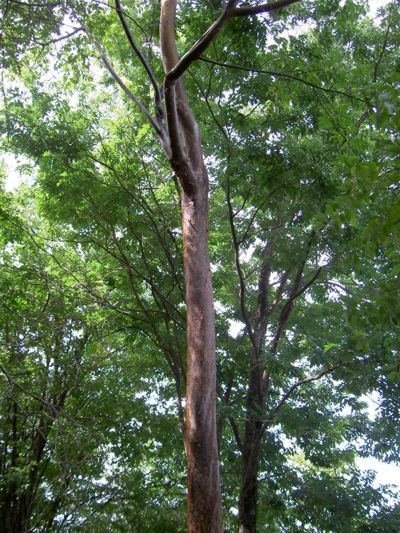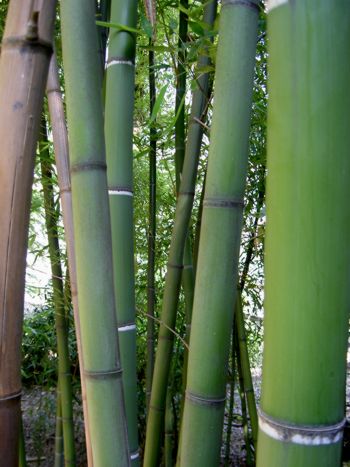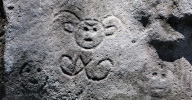| Kaz | Enfo | Ayiti | Litérati | KAPES | Kont | Fowòm | Lyannaj | Pwèm | Plan |
| Accueil | Actualité | Haïti | Bibliographie | CAPES | Contes | Forum | Liens | Poèmes | Sommaire |
What’s really needed to be done to reforest Haiti?
Emmanuel W. Védrine
(Feb. 2007)
 |
Bursera simaruba - Burseraceæ - Gonmye. Photo F.P. |
Deforestation has been one of Haiti’s main problems destroying its environment. So, nothing concrete has been done so far to solve that problem, or any long term program in the future. There has been recent talks of cooperation between Brazil and Canada to help Haiti with reforestation, according a Haiti’s local radio broadcasting: “Brazil and Canada announced on Monday (Feb. 5, 2007) their intention to bring technical and financial resources to a reforestation project in Haiti. This announcement was made by the Brazilian Minister of Foreign Affairs, Celso Amorim, at the conclusion of an interview with the Canadian Chief of Diplomacy, Peter MacKay in the presence of Fritz Longchamp, president Preval’s cabinet chief1.”
Though members from any foreign country can go to Haiti to help somehow, but still one of the Haiti’s biggest problems is the absence of “leadership”. In this term, we see “political will” in which we can see “love to do the maximum for one’s country”. Professor Gerald Murray, an American Anthropologist, who researched in Haiti for ten years (based in Tomazo), presented a paper at the University of Massachusetts-Boston in the early 80’s when I was attending this institution as student. He reports that he participated in a project planting one million trees; among them, many that bore fruits. “But what happened next?”, he asked.
When he went back to Haiti after few years later, he realized that they’ve cut down many of them to make charcoal. Why charcoal? Why do Haitian peasants cut down trees to make charcoal? Charcoal constitutes over 80% of a (burning) source of energy in Haiti, and most of all, since most peasants in Haitian can’t rely on cash crops when they don’t have them either on any Creole pig, so making charcoal appears to be a substitution for the two in order to survive. For those who have read my first novel “Sezon sechrès Ayiti” (Season of drought in Haiti), would have a broader picture of this terrible ecological problem killing the Haitian environment.
With hunger that exists in Haiti from time to time, here we see that it’s important in any reforestation program to include trees that bear fruits. I have a long list in my own research on the subject (see “Kèk plant kreyòl ak non yo an laten”, Some Creole plants and their names in Latin). The deforestation problem in Haiti is not something that started out in the 20th century, but rather back in the 19th century when France threatened to retake Haiti (as its colony) if the young Black Republic would not agree to pay an indemnity for the damages caused against France during the Haitian Revolution (see this article, “Agriculture: the first target for Haiti's development”). As I’ve indicated in this text, Haiti did not have a choice under president Jean-Pierre Boyer. So, it had to start a huge deforestation campaign in its great forests by cutting down mahogany trees to sell them (abroad) in order to start paying France.
Many of us would say, “hey, it’s important for Haiti to have a ministry of environment”. Well, we would not say some Haitians think wrong if they utter it. Yes, it is important and at the same time, if a minister of environment sits down like a monkey wearing a tie all day long doing nothing, we would have to ask: what on earth is going on? Shouldn’t he have to travel around the country to see its ecological problems, the destruction of the environment, give reports of what he sees, try to invite group of Haitians and foreigners who are trying to do some works (or who have done some works) related to the issue or that would be sensitive to this particular issue?
“In Port-au-Prince, the Minister of Education could make arrangement with the schools once a week where students can go and plant trees. Schools could take turn doing it. A commission would be put up in order to make students become sensitive to the issue, and also to teach them what distance to plant (from one tree to another). I know they would be motivated. Besides all of this, a whole organization would have to take part in this project (such as the police, former forest agents, the Red Cross, etc.”)2.
I even go further in my research and discussions (whether when attending conferences or taking part in on-line discussions) for the public schools in Haiti to take Fridays off in order to do activities with students to make them participate in some projects that would be undertaken by the government (such as: the construction of a school, a clinic, a hospital, visiting construction sites across the country in order to expose them to Haiti’s reality the way it is, and tell the youngsters that they are responsible as young citizen to participate in the country’s reconstruction and let them know that they will be tomorrow’s leaders), and make them participate in reforestation projects by showing them also how to make nurseries (of plants and vegetables), teach them plants that reproduce through their roots and how our peasants use the moon when planting. All of this has to do with the country’s reality, something that has never been taught in school for real.
There are students born right in Port-au-Prince (the capital city) and have never seen a peanut plant, a yucca plant, and many other Creole plants that exist in Haiti. So, these students are, in a way, foreigners in their own land. All of this is part of Haiti’s schools problems, part of leadership problem, problem of those who are at the head of something (in any domain) because if an individual is in a leadership position, we believe that he should try to do something positive to help his community, his country or his surrounding.
We think that the big ecological problem in Haiti should concern all Haitians (whether they think about it or not), and we, who are, in Diaspora who have the means (be it financial or the internet to communicate), can play our own part. But, we must work together. Group of people, in Diaspora, who are concerned should be met at least twice a year (in New York, Miami, Boston or Montreal) for conferences, not only to talk about this crucial problem, but also to look at all possible solutions. Among these solutions, we can raise the following questions: What is such and such group is trying to do in their native region in Haiti? Do they try to organize people in their native region in Haiti? How is their native region? Can they go to Haiti with other groups of people to do some work? For instance, I would pretty much like to participate in a team of people who would like to go to Haiti to plant bamboo trees. There are particular areas in Haiti where bamboo trees need to be planted in order to protect the cream of the land when there is big inundation.

NOTES & REFERENCES
(including of some writings dealing with the subject)
- RADIO METROPOLE. (an article entitled “Coopération entre le Brésil et le Canada pour la
reforestation d'Haïti”). French - English translation: E. W. Védrine.
- DALENCOUR, Eveline. (“Haitian Politics”, on-line forum – Feb.2007). French - English translation: E. W. Védrine.
René, Jean Erich. «Kijan yon plant fèt». Boston, MA: VEDCREP.
René, Jean Erich. «Rasin yon plant». Boston, MA: VEDCREP.
Védrine, Emmanuel W. 2007. «Ki lang k ap gen batay la ayiti: kreyòl, fransè ou anglè?» Boston, MA: VEDCREP.
Védrine, Emmanuel W. 2007.Yon koudèy sou pwoblèm lekòl Ayiti (2ème. ed). Boston, MA: VEDCREP.
Védrine, Emmanuel W. 2005. «Estrateji pou rebwaze Ayiti». Boston, MA: VEDCREP.
Védrine, Emmanuel W. 2005. Sezon sechrès Ayiti (roman, 2ème. éd, 2005). Boston, MA: VEDCREP.
Védrine, Emmanuel W. 2004. «Agrikilti ta dwe premye sib nan devlopman Ayiti». Boston, MA: VEDCREP.
Védrine, Emmanuel W. 2004. «Agriculture: the first target for Haiti's development». Boston, MA: Boston Haitian Reporter.
Védrine, Emmanuel W. 2004. «Dialog on reforestation in Haiti». Boston, MA: VEDCREP.
Védrine, Emmanuel W. 2004. «Dyalòg sou rebwazman an(n) Ayiti. Boston, MA: VEDCREP.
Védrine, Emmanuel W. 2003. An annotated bibliography on Haitian Creole: A review of publications from colonial times to 2000. Coconut Creek, FL: Educa Vision.
Védrine, Emmanuel W. 2003. «Kèk plant kreyòl ak non yo an laten». Boston, MA: VEDCREP.
Védrine, Emmanuel W. 1999. «Ayiti, yon peyi ravaje nou dwe sispann detwi». Boston, MA: VEDCREP.
Védrine, Emmanuel W. 1999. «Haiti and the destruction of nature». Boston, MA: VEDCREP.
Védrine, Emmanuel W. 1994. «Ann pale de bwa ak fri Ayiti!» Boston, MA: VEDCREP.
Védrine, Emmanuel W. Haiti and self destruction Boston, MA: VEDCREP.
Emmanuel W. Védrine
E. W. VEDRINE CREOLE PROJECT, Inc.
P.O.B. 255962
Dorchester, MA 02125-5110 (U.S)
e_vedrine@hotmail.com, e_vedrine@yahoo.com
Kisa k dwe fèt reyèlman pou rebwaze Ayiti?
Emmanuel W. Védrine
(Fev. 2007)
 |
Richesse de la forêt hygrophile. Photo F.P. |
Debwazman se youn nan pwoblèm prensipal Ayiti ki detwi anviwonnman an. Donk, poko gen anyen konkrè ki fèt pou solisyone pwoblèm sa a, oubyen oken pwogram alontèm pou demen. Resamman, sot gen pale ki fèt sou sijè a de yon koperasyon ant Brezil ak Kanada pou ede Ayiti nan domèn rebwazman, dapre Radio Métropole: “Brezil ak Kanada anonse lendi (7 fevriye 2007) entansyon yo pou pote resous teknik e finansyè a yon pwojè rebwazman Ayiti. Minis Afè Etranjè brezilyen an, Celso Amorim, fè anons sa a pou te konkli yon entèvyou ak Chèf Diplomasi Kanadyen an, Peter MacKay an prezans Fritz Longchamp, chèf kabinè prezidan Preval”.
Malgre manm nenpòt lòt peyi kapab al Ayiti, yon fason, pou ede men youn nan gwo pwoblèm Ayiti toujou konsidere kòm absans «lidèchip». Nan mo sa a, nou wè «volonte politik» kote nou ka wè «lanmou pou fè maksimòm pou lapatri». Pwofesè Gerald Murray, yon antwopològ ameriken, ki fè rechèch Ayiti pandan dizan (kote l te baze nan Tomazo), prezante yon rechèch nan University of Massachusetts-Boston nan ane 80 yo lè m te etidyan nan enstitisyon sa a. Li rapòte ke l te patisipe nan yon pwojè ki plante yon milyon pyebwa; pami yo, anpil ladan yo pote fri. «Men kisa k pase aprè?», li mande.
Lè l retounen Ayiti apre kèk ane, li reyalize ke yo koupe anpil ladan yo pou fè chabon. Pou kisa chabon? Pou kisa peyizan ayisyen koupe pyebwa pou fè chabon? Chabon konstitiye 80% sous enèji (ki konsome ou itilize) Ayiti, e sa pa fini la, lefèt pifò peyizan ayisyen pa kapab konte sou danre (lè yo gen sa), ni tou yo pa gen kochon kreyòl (ki te youn nan baz ekonomi peyizan yo) donk fè chabon parèt kòm yon aktivite ki ranplase toulede pou kapab siviv. Pou moun ki li premye roman mwen an, Sezon sechrès Ayiti, y ap gen yon pi gwo imaj de tèrib pwoblèm ekolojik k ap tiye anviwonnman Ayiti a.
Ak pwoblèm grangou ki egziste Ayiti tanzantan, la a nou wè ke l enpòtan nan nenpòt pwojè rebwazman pou ta enkli pyebwa ki pote fri. Mwen gen yon lis byen long sou plant nan rechèch mwen pibliye (gade «Kèk plant kreyòl ak non yo an laten»). Pwoblèm debwazman Ayiti se pa yon bagay ki kòmanse nan ventyèm syèk, men pito nan diznevyèm syèk lè Lafrans te menase Ayiti pou retounen vin pran l (kòm koloni) pou domaj li te koze pandan Revolisyon Ayisyèn nan; gade atik sa a: «Agrikilti ta dwe premye sib nan devlopman Ayiti»). Kòm mwen endike nan tèks sa a, Ayiti pa t gen chwa sou prezidan Bwaye (Jean-Pierre Boyer) donk, fò l te kòmanse yon kanpay debwazman manch long kote l koupe bonjan bwa kajou nan forè l yo pou te vann dekwa pou te ka kòmanse peye Lafrans.
Anpil nan nou ta di, «hey, li enpòtan pou Ayiti ta gen yon Ministè Anviwonnman». Bon, nou pa ta di kèk Ayisyen ta mal panse si yo ta di sa. Wi, li enpòtan e alafwa, si yon minis anviwonnman ta chita pòtre yon makak ak kravat nan kou l chak jou ap grate santi, fò n ta mande dekiprevyen. Èske l pa ta dwe vwayaje tribòbabò nan peyi a pou wè pwoblèm ekolojik li, destriksyon anviwonnman an, bay rapò sou sa l wè, eseye envite gwoup ayisyen ak etranje k ap eseye fè kèk travay (oubyen ki fè kèk travay deja) ki an rapò ak sijè a e ki ta sansib a sijè patikilye sa a?
«Ministè Edikasyon an nan Pòtoprens te ka aranje l yon jan ak lekòl yo yon fwa pa semèn kote elèv yo te ka al plante pyebwa. Lekòl yo te ka gen tou pa yo pou fè sa. Ta gen yon komisyon sou pye pou ta fè elèv vin sansib sou sijè a, epi tout pou montre yo distans pou plante (ant chak plant). Mwen konnen se yon bagay ki ta motive yo. Mete sou sa, ta gen tout yon òganizasyon k ap patisipe nan yon tèl pwojè (tankou lapolis, ansyen ajan forestye, lakwa wouj, elt.»).2
Mwen menm al pi lwen nan rechèch ak diskisyon m yo (swa lè m nan konferans oubyen lè m patisipe nan diskisyon sou entènèt la) pou lekòl piblik yo Ayiti ta pran jou vandredi pou fè aktivite ak elèv, fè yo patisipe nan kèk pwojè gouvènman an ta antreprann (tèlke pa egzanp, konstriksyon yon lekòl, yon klinik, yon lopital, vizite chantye tout kote nan peyi a yon fason pou ekspoze yo a reyalite Ayiti a jan li ye, epi fè jèn sa yo konnen ke yo responsab, kòm jèn sitwayen, pou patisipe nan rekonstriksyon peyi a, fè yo konnen ke se yo menm k ap lidè demen), epi fè yo patisipe nan pwojè rebwazman kote yo dwe montre yo prepare pepinyè (plant ak legim), anseye yo plant ki repwodui pa rasin e kijan peyizan nou yo itilize lalin nan pou plante. Tout sa gen pou wè ak reyalite peyi a, yon bagay yo poko anseye vrèman nan lekòl.
Gen elèv ki fèt la a nan Pòtoprens (kapital peyi a) epi ki pa janm wè yon pye pistach, yon pye manyòk, ak anpil plant kreyòl ki egziste Ayiti. Donk, elèv sa yo, yon fason, se etranje yo ye nan pwòp peyi yo. Tout sa fè pati de pwoblèm lekòl Ayiti, sa fè pati de pwoblèm lidèchip, de pwoblèm sa yo ki alatèt yon bagay kèlkonk (nan nenpòt domèn) paske si yon moun nan yon pozisyon lidèchip, nou kwè ke l ta dwe eseye fè yon bagay pozitif pou ede komite l, peyi l ak anviwonnman l.
Nou panse gwo pwoblèm ekolojik Ayiti a dwe konsène tout Ayisyen (ke yo panse a li ou pa), e nou menm ki nan dyaspora a, ki gen mwayen (ke l finansyè oubyen mwayen pou kominike atravè entènèt la), kapab jwe patisyon pa nou men, nou dwe travay ansanm. Gwoup moun, nan dyaspora a, ki konsène ta dwe rankontre omwen de (2) fwa lan (Nouyòk, Miyami, Boston oubyen Monreyal) pou konferans, pa sèlman pou pale sou gwo pwoblèm sa a, mwen tou pou gade tout solisyon posib yo. Pami solisyon yo, nou ka poze kesyon sa yo: Kisa tèl ou tèl gwoup ap eseye fè nan pwòp rejyon yo Ayiti? Èske yo eseye òganize moun nan pwòp rejyon yo Ayiti? Ki jan rejyon yo a ye? Èske yo ka desann Ayiti ak kèk lòt gwoup moun pou fè kèk travay? Pa egzanp, mwen ta renmen patisipe ak yon ekip moun ki ta renmen desann Ayiti pou al plante banbou. Gen zòn patikilye Ayiti kote yo ta dwe plante banbou pou pwoteje krèm tè a lè gen gwo inondasyon.
 |
Banbou. Photo F.P. |
NÒT & REFERANS
(enkli kèk piblikasyon sou sijè a)
- RADIO METROPOLE. (yon atik ki rele «Coopération entre le Brésil et le Canada pour la réforestation d'Haïti»). Tradiksyon fransè - anglè: E. W. Védrine.
- DALENCOUR, Eveline. (“Haitian Politics”, on-line forum – Feb.2007). Tradiksyon fransè - anglè: E. W. Védrine.
René, Jean Erich. «Kijan yon plant fèt». Boston, MA: VEDCREP.
René, Jean Erich. «Rasin yon plant». Boston, MA: VEDCREP.
Védrine, Emmanuel W. 2007. «Ki lang k ap gen batay la ayiti: kreyòl, fransè ou anglè?» Boston, MA: VEDCREP.
Védrine, Emmanuel W. 2007.Yon koudèy sou pwoblèm lekòl Ayiti (2ème. ed). Boston, MA: VEDCREP.
Védrine, Emmanuel W. 2005. «Estrateji pou rebwaze Ayiti». Boston, MA: VEDCREP.
Védrine, Emmanuel W. 2005. Sezon sechrès Ayiti (roman, 2ème. éd, 2005). Boston, MA: VEDCREP.
Védrine, Emmanuel W. 2004. «Agrikilti ta dwe premye sib nan devlopman Ayiti». Boston, MA: VEDCREP.
Védrine, Emmanuel W. 2004. «Agriculture: the first target for Haiti's development». Boston, MA: Boston Haitian Reporter.
Védrine, Emmanuel W. 2004. «Dialog on reforestation in Haiti». Boston, MA: VEDCREP.
Védrine, Emmanuel W. 2004. «Dyalòg sou rebwazman an(n) Ayiti. Boston, MA: VEDCREP.
Védrine, Emmanuel W. 2003. An annotated bibliography on Haitian Creole: A review of publications from colonial times to 2000. Coconut Creek, FL: Educa Vision.
Védrine, Emmanuel W. 2003. «Kèk plant kreyòl ak non yo an laten». Boston, MA: VEDCREP.
Védrine, Emmanuel W. 1999. «Ayiti, yon peyi ravaje nou dwe sispann detwi». Boston, MA: VEDCREP.
Védrine, Emmanuel W. 1999. «Haiti and the destruction of nature». Boston, MA: VEDCREP.
Védrine, Emmanuel W. 1994. «Ann pale de bwa ak fri Ayiti!» Boston, MA: VEDCREP.
Védrine, Emmanuel W. Haiti and self destruction Boston, MA: VEDCREP.
Emmanuel W. Védrine
E. W. VEDRINE CREOLE PROJECT, Inc.
P.O.B. 255962
Dorchester, MA 02125-5110 (U.S)
e_vedrine@hotmail.com, e_vedrine@yahoo.com
